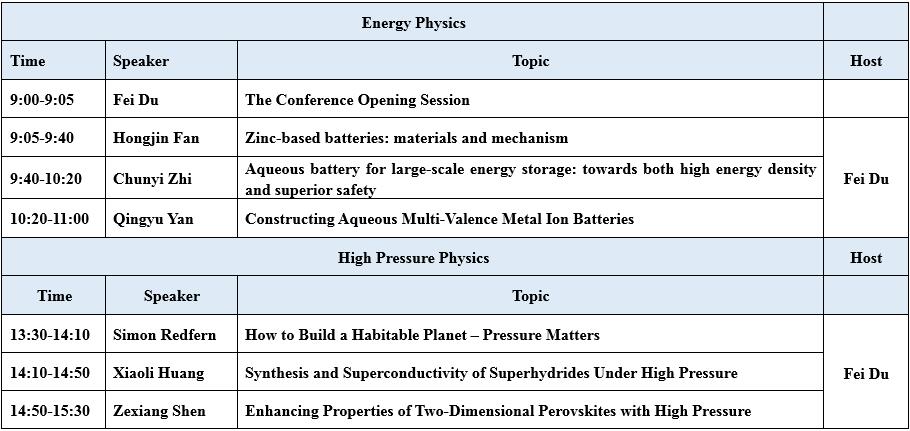本项目由bwin必赢登录入口官网与新加坡南洋理工大学、香港城市大学联合举办,围绕能源物理、高压物理等方向开展交流与讲座,提升吉大学子全球胜任力。
时间:2021年3月14日 9:00-15:00(北京时间)
Time: 9:00-15:30(UTC+8)March 14, 2021
Zoom ID:868 4841 2605 Passcode:414111
主讲人 Keynote Speaker
【Energy Physics】
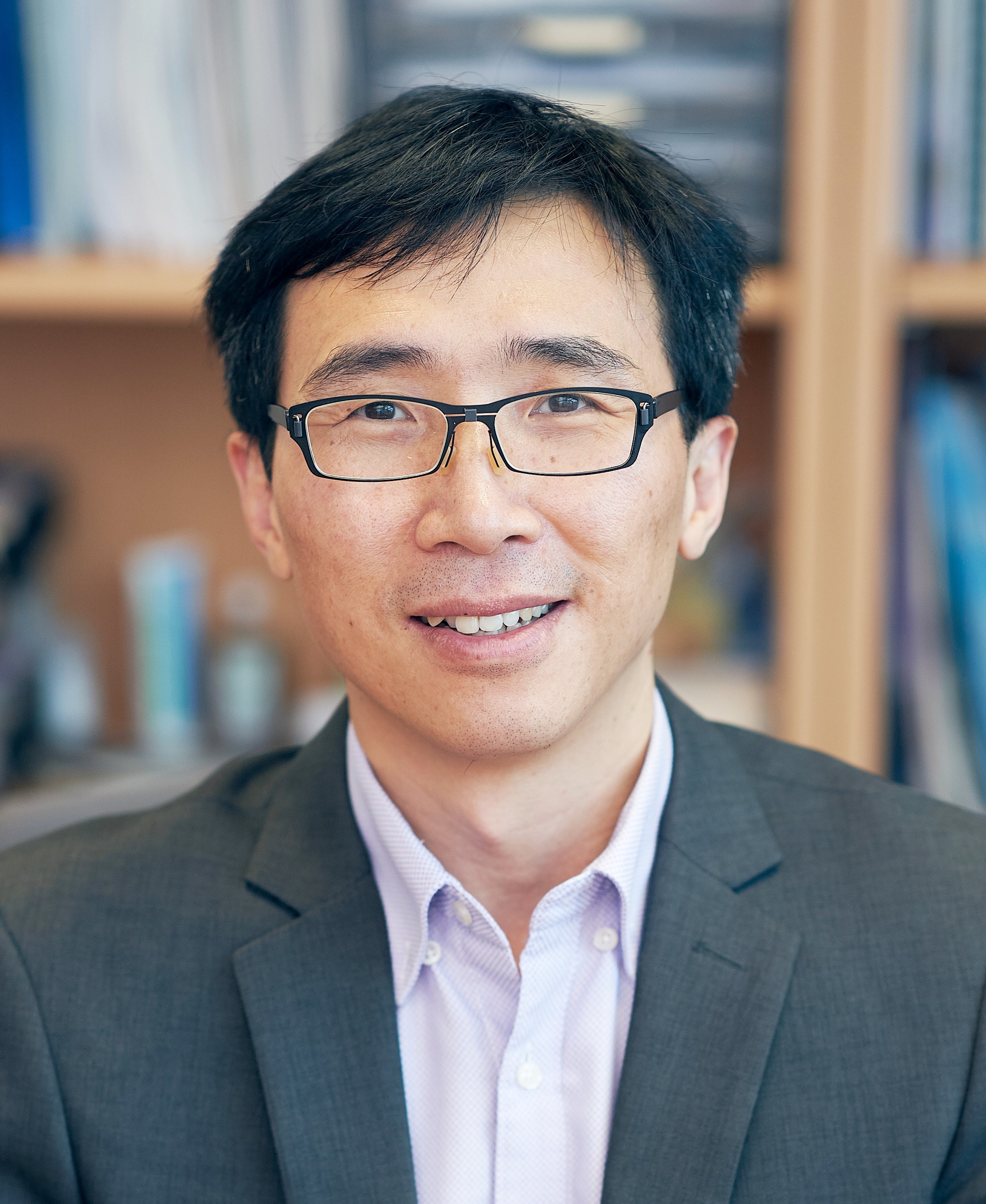
Hong Jin Fan
Biography:
范红金,新加坡南洋理工大学数理学院教授。1999年获必赢电子游戏网站物理学士学位,2003年获新加坡国立大学物理系博士学位,其后分别在德国马普研究所和英国剑桥大学从事博士后工作。2008年加入南洋理工大学至今。半生科研路,一世象牙塔。往后余生,春花秋黄荣华平淡估计都是她(科研)。
范教授目前的主要研究领域为纳米材料和能源应用,包括钠离子和锌离子电池,杂化储能器件,和光电催化。已经发表论文245篇,H-指数 83。范教授担任多个国际期刊编辑和编委。现任 Materials Today Energy (MTE) 主编。从2016 起连续成为材料类全球高被引作者。
Title:Zinc-based batteries: materials and mechanism
Abstract:Rechargeable aqueous zinc ion battery (AZIB), as a novel promising candidate for grid-scale energy storage, has garnered tremendous attention recently. Revamping the electrochemistry and redesigning of the electrolyte and interface have led to performance enhancement of AZIB. The number of research groups actively working on AZIBs is increasing, so as the number of Review articles on various aspects of AZIB, from nanostructured electrode design, electrolyte chemistry, dendrite issues, to low-temperature operation. In this talk, I will first present a summary of recent advance in AZIB with a focus on Zn-MnO2 batteries. A general classification of working mechanisms related to MnO2 cathode is elaborated, which may lead to commercialization of Zn-MnO2 flow batteries for large-scale static energy storage. I will also present a few examples of our own studies on both vanadium oxide cathode and organic cathode materials and the elucidation of the charge storage mechanism. Zn-ion hybrid capacitors with low discharge rates will also be presented.
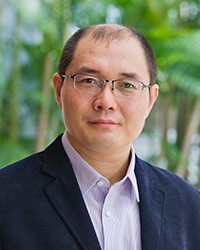
Chunyi Zhi
Biography:
支春义,男, 2004年中科院物理所取得博士学位,随后到日本物质材料研究机构工作,历任博士后研究员,研究员(faculty)以及主任研究员(永久职位)。目前在香港城市大学材料科学与工程系任教授。研究方向为可穿戴柔性电存储器件,包括多水系电解质,高安全电池和金属空气电池等。到目前为止,已发表有关SCI论文超过300篇,他引超过23000次(ISI),H因子为86,专利授权80项。支春义博士是Clarivate Analytics高被引科学家(2019,2020,材料科学),香港青年科学院Member, RSC fellow,获得城大校长奖,青年杰出研究奖,北京市自然科学一等奖。
Title:Aqueous battery for large-scale energy storage: towards both high energy density and superior safety
Abstract:Development of energy storage system in the past year focus on improvement of energy density. While the progress is remarkable, safety problems of lithium ion batteries (LIB) have been intensively exposed. On one hand, LIB is not intrinsically safe with very active anode, flammable electrolyte and oxygen-releasing cathode; on the other hand, many application scenarios actually don’t require very high energy density.
We work on aqueous electrolyte batteries to achieve both high energy density and superior safety performance. we show how to activate the desired reversible I0/I+ redox at a potential of 0.99 V vs. SHE by electrolyte tailoring via F-, Cl- ions-containing salts. The electronegative F- and Cl- ions can stabilize the I+ during charging. In an aqueous Zn ion battery based on an optimized ZnCl2 + KCl electrolyte with abundant Cl-, I-terminated halogenated Ti3C2I2 MXene cathode delivers two well-defined discharge plateaus at 1.65 V and 1.30 V, superior to all reported aqueous I2-metal (Zn, Fe, Cu) counterparts. Together with the 108% capacity enhancement, the high voltage output results in a significant 231% energy density enhancement.
In addition, we also develop various approaches to stabilize the Zn anode. We accurately quantifying the hydrogen evolution in Zn metal battery by in-situ battery-gas chromatography-mass analysis. Then, we propose an vapor-solid method for an highly electronically insulating (0.11 mS×cm-1) but high Zn2+ ion conductive (80.2 mS×cm-1) ZnF2 solid ion conductor with high Zn2+ transfer number (0.65) to isolate Zn metal from liquid electrolyte, which can not only prohibit over 99.2 % parasitic hydrogen evolution reaction during cycling but also guide uniform Zn electrodeposition. Meanwhile, Zn@ZnF2//Zn@ZnF2 symmetric cell exhibits excellent stability over 2500 h (over 6250 cycles) with 1 mAh×cm-2 of Zn reversibly cycled at 5 mA×cm-2, and stable cycling under ultrahigh current density and areal capacity (10 mA×cm-2, 10 mAh×cm-2) over 590 h (285 cycles), which far outperforms all reported Zn metal anode in aqueous system. In light of the superior Zn@ZnF2 anode, the practical-level aqueous Zn@ZnF2//MnO2 batteries (~3.2 mAh×cm-2) shows remarkable cycling stability over 1000 cycles with 93.63 % capacity retained at ~100 % coulombic efficiency.
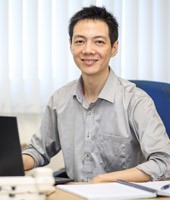
Qingyu Yan
Biography:
Qingyu Yan is currently a professor in School of Materials Science and Engineering in Nanyang Technology University. He obtained his BS in Materials Science and Engineering, Nanjing University. He finished his PhD from Materials Science and Engineering Department of State University of New York at Stony Brook. After that, He joined the Materials Science and Engineering Department of Rensselaer Polytechnic Institute as a postdoctoral research associate. He joined School of Materials Science and Engineering of Nanyang Technological University as an assistant professor in early 2008 and became a Professor in 2018.
He is currently the Chair of the Electrochemical Society, Singapore Section. He is a fellow of Royal Society of Chemistry Since 2018. Yan has published more than 300 papers (with total citation of >28000 and h index of 87) on two research area: (1) thermoelectric materials; (2) electrochemical properties of materials for energy storage or conversion.
Title:Constructing Aqueous Multi-Valence Metal Ion Batteries
Abstract:Aqueous Al-ion batteries (AAIBs) are the subject of great interest due to the inherent safety and high theoretical capacity of aluminum. The high abundancy and easy accessibility of aluminum raw materials further make AAIBs appealing for grid-scale energy storage. However, the passivating oxide film formation and hydrogen side reactions at the aluminum anode, as well as limited availability of cathode lead to low discharge voltage and poor cycling stability. Here, we proposed a new AAIB system consisting of AlxMnO2 cathode, zinc substrate supported Zn-Al alloy anode and an Al(OTF)3 aqueous electrolyte. Through the in-situ electrochemical activation of MnO, the cathode was synthesized to incorporate a two-electron reaction, thus enabling its high theoretical capacity. The anode was realized by a simple deposition process of Al3+ onto Zn foil substrate. The featured alloy interface layer can effectively alleviate the passivation and suppress the dendrite growth, ensuring ultralong-term stable aluminum stripping/plating. The architected cell delivers a record-high discharge voltage plateau near 1.6 V and specific capacity of 460 mAh g-1 for over 80 cycles. This work provides new opportunities for the development of high-performance and low-cost AAIBs for practical applications.
【High Pressure Physics】
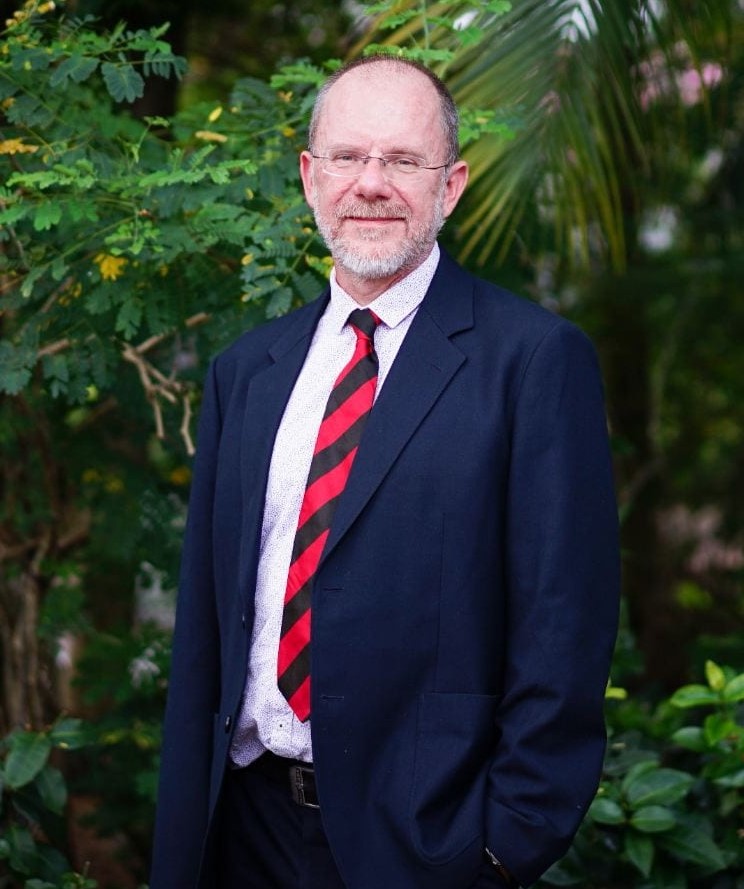
Simon Redfern
Biography:
Prof. Simon Redfern is President’s Chair in Earth Sciences at the Asian School of the Environment and also Dean of the College of Science, Nanyang Technological University, Singapore. He joined NTU Singapore a little more than 18 months ago after a career at the University of Cambridge where he was Head of the Department of Earth Sciences. He is a fellow of Jesus College, Cambridge.
His current research work involves experimental and computation studies of silicates and other oxides under varying conditions, including high pressure. He uses synchrotron, neutron and laboratory sources to understand structure via diffraction and spectroscopy. Most of his work has focused on structural phase transitions and the thermodynamic controls on structure, and consequences on properties. He is winner of the European Medal for Research Excellence in mineral sciences, and the Max Hey and Schlumberger medals of the mineralogical society and has served on UK and EU governmental advisory panels.
Title:How to Build a Habitable Planet – Pressure Matters
Abstract:Although “ambient conditions” for us, 300 K and 0.1 MPa is the exception, not the norm, for matter in the solar system. While deep space is cold and ultra-low pressure, the condensed material in the universe is generally under what we think of as “extreme conditions”. We only have to travel 6,371 km from our home (not much further than the distance from Changchun to Singapore) to find matter sitting at around 6000 K and 330 GPa. As observations and understanding develop, it is becoming clear that planetary objects in our solar system as well as those orbiting distant stars share a number of things in common, however. The bulk composition of the Earth, for example, is predominantly (95%) composed of just five elements: Fe, O, Si, Mg and Ca. But the Earth is no exception. Meteorites, the debris from earlier planets and proto-planets formed at the origin of the Solar System, contain the same minerals that we find on Earth. Observations of polluted white dwarf stars give estimates of the bulk composition of planetary material of exoplanets around those stars, and show the same patterns of chemical composition. It is unsurprising that the physics and chemistry that we observe here on Earth operates universally, but our own “ambient conditions” do bias our intuition and expectations. I will report some recent high-pressure studies that overturn our understanding of chemistry, based on the pattern of bonding seen at 0.1 MPa, when extended to the extreme conditions of planetary, moon and stellar interiors, and pose some questions on how such conditions in planets might also guide our understanding of materials design.
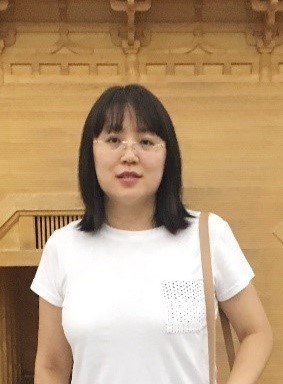
Xiaoli Huang
Biography:
黄晓丽,必赢电子游戏网站教授,一直从事高压下富氢化物的晶体结构及超导电性研究,取得了突破性进展:自主改进并优化了百万大气压以上原位电阻和磁化率的测量技术,成功实现了富氢化物超高压下超导零电阻和迈斯纳效应实验测量;设计并制备了分别具有原子氢和分子氢构型的新型富氢化物,提出了氢构型、费米能级处的态密度及外层f电子是影响富氢化物超导电性的内在关键因素,为设计具有高温超导电性的新型富氢化物提供了新思路。在Nat. Comm.、Sci. Adv.及JACS等期刊发表50余篇SCI论文,他引500余次,其中1篇Sci. Adv.入选ESI高被引论文,1篇Nat. Comm.被编辑选为亮点文章。荣获必赢电子游戏网站唐敖庆领军特聘教授、福谦青年科学家奖。
Title:Synthesis and Superconductivity of Superhydrides Under High Pressure
Abstract:Room-temperature superconductors have long been the ultimate goal of scientists. Superhydrides exhibit abundant crystal structures and electronic structures under high pressure. They are the forefront of physics, materials science and superconductivity. Recently, researchers have discovered binary H3S and LaH10 with Tc up to 203 K and 260 K, respectively. In this respect, these findings sets a new record for superconductivity, a step closer to room-temperature superconductivity. Our work have chosen typical metal hydrides as the research targets. The crystal structure and stoichiometric ratio of new superhydrides were studied by in-situ synchrotron X-ray diffraction combined with first-principles calculation method. The important zero resistance superconducting measurement is carried out to obtain the superconducting transition temperature and the superconducting critical magnetic field is further explored by using in situ high-pressure resistance measurements. The relationship among crystal structure, superconductivity and electronic structure is further established to reveal the critical factors of superconductivity. The present work deepens the understanding of superconductivity in hydrogen-rich systems and provides a new route for metallic hydrogen and high-temperature superconductors.
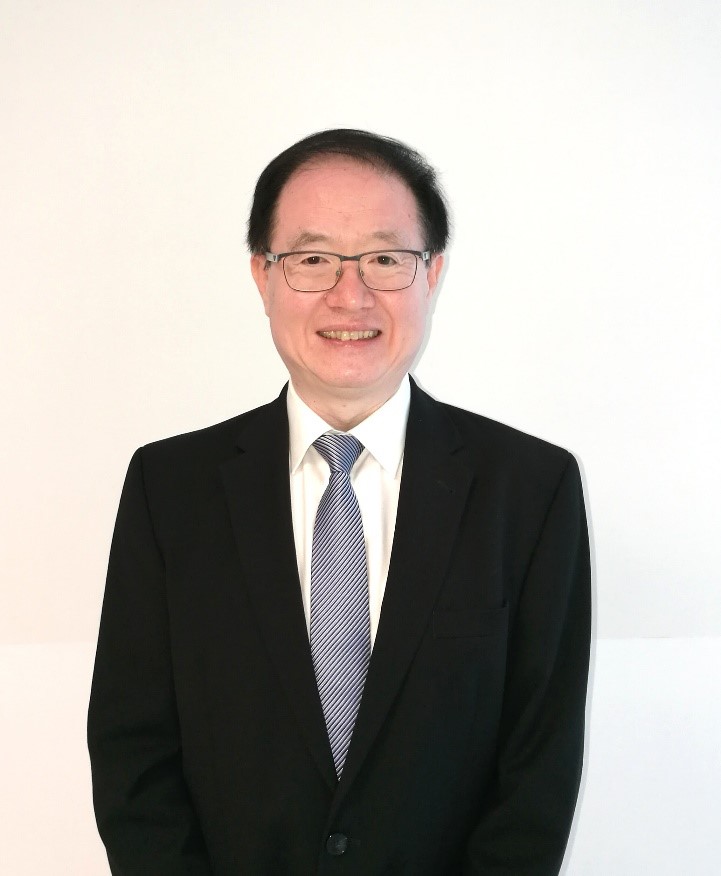
Zexiang Shen
Biography:
Prof. Zexiang Shen is Professor of Physics. He is Associate Dean for interdisciplinary research, Graduate College, Nanyang Technological University. He is also Co-Director, Centre for Disruptive Photonics Technologies. He also holds a joint appointment at School of Materials Science and Engineering.
His current research work involves spectroscopic and theoretical study of graphene, 2D materials and hybrid perovskites using ultra Low wavenumber Raman spectroscopy, photoluminescence and time resolved spectroscopy in combination with high pressure and low temperature. His other research direction is electric energy storage using graphene composite materials. He is winner of NTU Nanyang Award for Research and Innovation, Gold Medal for Research Excellence by Institute of Physics Singapore, Honorary Professor of Moscow State University. He is a Global Highly Cited Researcher.
Title:Enhancing Properties of Two-Dimensional Perovskites with High Pressure
Abstract:Two-dimensional (2D) perovskites are a new class of functional materials with potential applications in various technologically important areas, such as solar cells, LED and lasing. Compared with their 3D counterparts, 2D perovskites exhibit special properties, e.g. their natural quantum-well structure yields stable excitons, able to interact more strongly with phonons, spins and defects. Layered perovskites are also more structurally stable.
High pressure induces a rich variety of phenomena in the electronic and optical properties in the hybrid Perovskite materials, including enhancement of photoluminescence (PL) by at least two orders of magnitude, narrow to white light emission, rich PL energy and lifetime changes. The optical properties of 2D perovskites are mainly governed by excitons, and the investigation of intrinsic and extrinsic, radiative and nonradiative exciton recombination pathways is essential. The intrinsic pathways are related to exciton-phonon interactions. Lattice vibrations create spatial and temporal potential fluctuations, where the first one causes scattering of excitons and broadening of excitonic peaks in optical spectroscopy, while the second leads to the fine structure of the spectra, known as Frank-Condon shape. Besides, a moving exciton is able to create vibrations around it, inducing lattice distortions.
